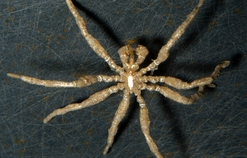
The elytra have become detached, and those belonging to the smallest specimen are lost. Those belonging to the largest example (fig. 4b) are huge, leathery, reniform structures, meas uring about 30 mm. by 21 mm. at the widest part. They are flesh-coloured, with the border op posite the hilum pigmented dark brown. Near the hilum they are thickly covered with small tubercles, but the rest of the scale has a dense covering of longer and shorter spines (fig. 4e) resembling those of Harmothoë crosetensis, interspersed with rather soft ovate vesicles. Both spines and vesicles are largest near the border opposite the hilum (fig. 4d). The elytra of the second of the large specimens are relatively considerably smaller, and are splashed with brown markings. They differ from those of the largest specimen in that the ovate vesicles are absent and are replaced by a relatively small number of gigantic tubercles surmounted by clusters of long spines (fig. 4e).
The elytrophores are prominent, and pseudo-elytrophores are present. The dorsal cirri are set low down on the feet, and the cirrophores have a prominent lateral expansion. The dorsal cirri are lost in all except the smallest specimen, and in this they are hirsute, and reach to the end of the ventral bristles. The ventral cirri reach to the end of the foot.
The feet (fig. 4f) resemble those of Eulagisca corrientis (see Monro, 1930, fig. 11b). The dorsal ramus sends out a long sheathed aciculum behind and below the dorsal bristle bundle. The ventral ramus has a longer sheather aciculum in front of the ventral bristle bundle.
The dorsal bristles (fig. 4g) are very numerous, almost as long as the ventral, rather slender and pectinated. The ventral bristles (fig. 4h) are more numerous and finer than the dorsal. They have frills extending over about a quarter of their length, and a rather long and delicate uni-dentate naked tip. The anus is terminal.
This species is close to the type-species, E. corrientis McIntosh, but differs chiefly in the ornamentation of the elytra. The elytra of E. corrientis are smooth. McIntosh described them as comparatively smooth over the greater part of the area, and having a few clavate cilia at the pos terior border. Of the Discovery Committee's material a specimen from the Palmer Archipelago has a few elytra, and these agree with McIntosh's account, except that I see no cilia. Moreover. I suspect that the specimens attributed to McIntosh's species by Benham (1921, 43) may belong to the present species. Benham, in describing one of the second pair of scales, writes, "there are three large, broad, round-tipped conical tubercles near the external margin, and springing from the surface of the scale between them, but nearer to the margin are a few long, fine, cylindrical hair-like papillae. The concealed portion of the elytron bears numerous small, rounded, low, and highly refringent tubercles, only visible under a high magnification. There is no fringe."
At any rate the elytra in Benham's specimens were not smooth as in E. corrientis. Benham's account of the elytra is not in close agreement with those of my specimens, but that the ornamen tation is variable is shown by the differences between the elytra of the two larger specimens already noted.”
(Monro, 1939)



